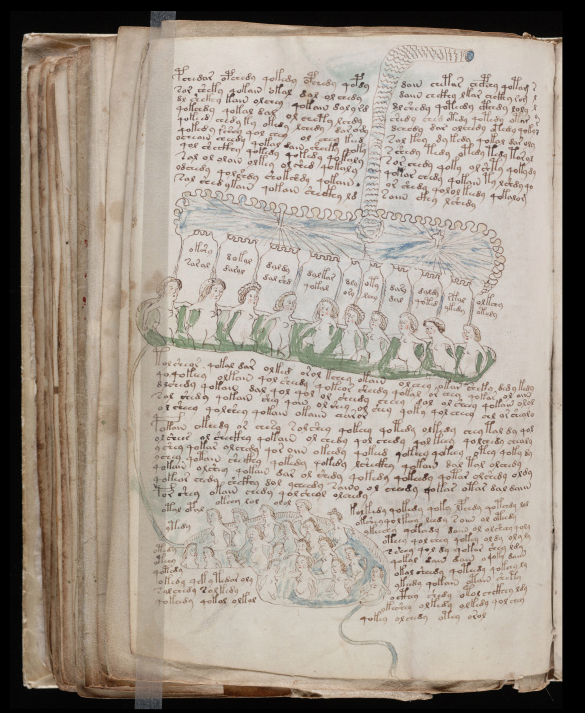

- #Voynich manuscript translation full
- #Voynich manuscript translation code
- #Voynich manuscript translation crack
1921: Harper’s Magazine publishes an article about the manuscript under the title “The Most Mysterious Manuscript In The World.” The manuscript became a phenomenon among cryptographers and medievalists.The circumstances of the purchase are unclear, but it seems it was part of a set of books sold by Jesuits from the Collegio Romano. 1912: The manuscript is purchased by Wilfrid Michael Voynich, whose name is forever attached to it.1670 to 1912: Honestly, no one knows for sure.Some time around 1665, the manuscript is added to a collection of papers belonging to Jesuit scholar Athanasius Kircher. The letter claims that the manuscript was “sold to Holy Roman Emperor Rudolf II at a reported price of 600 ducats and that it was believed to be a work by Roger Bacon.” It was later proved that Roger Bacon, an English alchemist, was not the author of the text. August 19, 1665: This is the date on a letter written by Johannes Marcus Marci, which was found in the manuscript in the 20th century.Researchers also believe, based on markings on the manuscript, that it’s from Italy. Early 15th Century: By carbon dating the manuscript, researchers are pretty confident that it was constructed in the early 1400s.In any case, here’s a brief timeline of the manuscript’s history: Where it comes from is, as to be expected, pretty hard to pin down.
#Voynich manuscript translation full
The full manuscript is available for viewing online, thanks to Yale University. Based on the images alone, it seems to be some guide to astrological herbology, and most assume it has something to do with medicine. It also features many weird illustrations of unknown plants, people and astrological charts. The Voynich manuscript is a 234-page tome filled with writing in a strange language now called Voynichese. Since its discovery, it has obsessed researchers, been called a hoax, been the subject of a huge number of articles (including this one!), and still, after years and years of being examined by brilliant minds, completely eluded deciphering. While it’s pretty inconsequential - the language in the manuscript appears nowhere else - it’s become one of the greatest linguistic riddles of our day.
#Voynich manuscript translation crack
To understand exactly how challenging it is to crack a mystery language, we can look at one that still remains a riddle: the Voynich manuscript. Would historians have been able to decipher the hieroglyphs without the Rosetta Stone? While there have been huge advances in linguists’ code-breaking abilities, it’s possible that it would still remain a mystery without some translation help. Using knowledge of the Greek, Egyptologist Jean-Francois Champollion was able to translate the texts for the first time. The Rosetta Stone also advertised the fact that it was the same text written three times in various languages. While the Egyptian languages had been dead for two millennia, written Greek was a language that scholars could read. Its importance hinged on the fact that it was written in three languages: Egyptian hieroglyphics, Egyptian demotic (the less formal writing system in ancient Egypt) and, most importantly, Greek.

In the late 18th century, as France’s Napoleon Bonaparte was having his soldiers raid Egypt for antiquities, someone stumbled upon a large black basalt slab. Ancient Egyptian culture was nearly lost. The Egyptians wrote with a writing system that, up to the 18th century, no one could figure out. Archaeologists investigated the pyramids and cities, but there was a huge gap in understanding: the hieroglyphs. The reader can now continue the laborious translation and discover with us the thoughts of on apothecary and physician of the 15th century, at least his secrete thoughts on biology the zodiac.For many centuries, ancient Egypt was a mystery to historians. This permitted the translation of the first pages of the manuscript, proposed in English and French, with a glossary giving the Voynich word and its Greek translation.
#Voynich manuscript translation code
By searching for common words, found in electuaries, such as the Theriac: Snake, Valerian, Opium, as well as expressions used by apothecaries: wash - cut - filter- chop, or even the expression "e as custom"e, that were picked out in the text, we noticed that when written in Greek the alphabetic code could be immediately deciphered. Evidently illustrations tell us that it is "e a medical"e text. The beautiful illustrations and drawings are associated to a long text written in a coded alphabet that had never been deciphered. This manuscript is currently in the library of Yale University. It owes its name to Wilfrid Voynich, who bought it from the Jesuits in 1912 near Rome. This manuscript is a wonderful 15th century manuscript on wove paper. Our book is a translation of the first part of the Voynich manuscript.


 0 kommentar(er)
0 kommentar(er)
